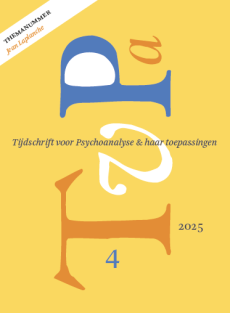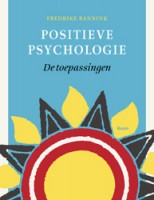Indicatie voor Psychoanalyse: wie bepaalt de grenzen?
Summary
The author discusses several factors playing a role in the process of assessment for psychoanalysis.
Emphasis is placed on the role of the psychoanalyst, on his conception of the goal of psychoanalysis and his capacity to achieve this goal, which will be significantly influenced by unconscious motives and character traits.
During psychoanalytic treatment the patient-analyst relationship is of central importance. It also plays a major role during the diagnostic assessment. This important factor has implications for diagnostic procedure in institutes, where usually several analysts are involved in the assessment.
Research (e.g. Fonagy et al. 1995) has shown that a good self-reflective function in the mother has a beneficial effect on the mother-child relationship. From the viewpoint of prevention it therefore seems important to help young women with the development of the self-reflective function through psychoanalytic treatment.
Literatuur
- Bachrach, H.M., R. Galatzer-Levy, A. Skolnokoff, and S. Waldron (1991), On the Efficacy of Psychoanalysis. Journal of the American Psychoanalytical Association 39, p. 871-916.
- Blécourt, A. de (1991), Het samenwerkingsverbond (‘working-alliance’) van patiënt en analyticus. In: A. de Blécourt, Voelen, Denken en Handelen in de Psychoanalyse. Van Gorcum, Assen/Maastricht, p. 366-378.
- Eissler, K.R. (1953), The effect of the structure of the ego on psychoanalytic technique. Journal of the American Psychoanalytical Association 1, p. 104-143.
- Fonagy, P., M. Steel, H. Steel e.a. (1995), Attachment, the Reflective Self, and Borderline States. In: S. Goldberg e.a., Attachment Theory: social, developmental and clinical perspectives. Analytic Press, Hillsdale N.Y., p. 233-279.
- Fonagy, P. en M. Target (1996), Outcome Predictors in Child Analysis, Journal of the American Psychoanalytical Association 44 (1), p. 27-77.
- Freud, A. (1965), Normality and Pathology in Childhood. International Universities Press, New York.
- Freud, S. (1937), De eindige en de oneindige analyse. Nederlandse Editie: Klinische Beschouwingen 4. Boom, Meppel/Amsterdam, p. 225-265.
- Frijling-Schreuder, E.C.M., J.E.M. Bakker, F. Verhage (1988), Techniek van de Analyse bij Volwassenen en Kinderen. Van Gorcum, Assen.
- Greenson, D.P (1992), Assessment of Analyzability. In: A. Sugarman, R. Nemiroff and D. Greenson (Eds), The technique and practice of psychoanalysis, vol.2. International Universities Press, Madison, CT, p. 43-61.
- Jonghe, F. de, P. Rijnierse, R. Janssen (1992), The Role of Support in Psychoanalysis. Journal of the American Psychoanalytical Association 40 (2), p. 475-499.
- Kantrowitz, J.L., N.L. Katz, D.A. Greenman, H. Morris, F. Paolitto, J. Sashin, and L. Solomon (1989), The patient-analyst match and the outcome of psychoanalysis: a pilot study. Journal of the American Psychoanalytical Association 37, p. 893-919.
- Kantrowitz, J.L. (1997), A different perspective on the therapeutic process: the impact of the patient on the analyst. Journal of the American Psychoanalytical Association 45, p. 127-153.
- Kappelle, W. (1996), How useful is selection? International Journal of Psycho-Analysis 77, p. 1213-1233.
- Lampl-de Groot, J. (1967), On Obstacles standing in the way of Psychoanalytical Cure. In: J. Lampl-de Groot, Man and Mind. Van Gorcum, Assen/Maastricht, p. 284-294.
- Martin, G.C. (reporter) (1993), Panel: Stability of gains achieved during analytic treatment from a follow-up perspective. Journal of the American Psychoanalytical Association 41, p. 209-217.
- Olden, C. (1953), On Adult Empathy with Children. Psychoanalytical Study of the Child 8, p. 111-126.
- Oosterhuis, E. en F. Slijper (1995), Het Psychoanalytisch Proces in de Kinderanalyticus. Tijdschrift voor Psychoanalyse 1 (3), p. 167-179.
- Rangell, L. (1974), A psychoanalytic perspective leading currently to the syndrome of the compromise of integrity. International Journal of Psycho-Analysis 55, p. 3-12.
- Rothstein, A. (1995), Psychoanalytic Technique and the Creation of Analytic Patients. International Universities Press, Madison CT.
- Sandler, J. en A.U. Dreher (1996), What do Psychoanalysts want? Routledge, London.
- Sandler, J. en A.-M. Sandler (1993), Psychoanalytic Technique and Theory of Psychic Change. In: M. Horowitz (Ed.), Psychic Structure and Psychic Change: Essays in Honor of Robert S. Wallerstein, M.D. International Universities Press, Madison CT, p. 57-75.
- Stone, L. (1954), The widening scope of indications for psychoanalysis. Journal of the American Psychoanalytical Association 2, p. 567-594.
- Treurniet, N. (1993), Support of the Analytical Process and Structural Change. In: M. Horowitz, (Ed.), Psychic Structure and Psychic Change: Essays in Honor of Robert S. Wallerstein, M.D. International Universities Press, Madison CT, p. 191-232.
- Wallerstein, R.S. (1992), The goals of psychoanalysis reconsidered. In: A. Sugarman, R. Nemiroff and D. Greenson (Eds), The technique and practice of psychoanalysis, vol.2. International Universities Press, p. 63-90.
 © 2009-2025 Uitgeverij Boom Amsterdam
© 2009-2025 Uitgeverij Boom Amsterdam
ISSN 1382-516x
De artikelen uit de (online)tijdschriften van Uitgeverij Boom zijn auteursrechtelijk beschermd. U kunt er natuurlijk uit citeren (voorzien van een bronvermelding) maar voor reproductie in welke vorm dan ook moet toestemming aan de uitgever worden gevraagd:
Behoudens de in of krachtens de Auteurswet van 1912 gestelde uitzonderingen mag niets uit deze uitgave worden verveelvoudigd, opgeslagen in een geautomatiseerd gegevensbestand, of openbaar gemaakt, in enige vorm of op enige wijze, hetzij elektronisch, mechanisch door fotokopieën, opnamen of enig andere manier, zonder voorafgaande schriftelijke toestemming van de uitgever.
Voor zover het maken van kopieën uit deze uitgave is toegestaan op grond van artikelen 16h t/m 16m Auteurswet 1912 jo. Besluit van 27 november 2002, Stb 575, dient men de daarvoor wettelijk verschuldigde vergoeding te voldoen aan de Stichting Reprorecht te Hoofddorp (postbus 3060, 2130 KB, www.reprorecht.nl) of contact op te nemen met de uitgever voor het treffen van een rechtstreekse regeling in de zin van art. 16l, vijfde lid, Auteurswet 1912.
Voor het overnemen van gedeelte(n) uit deze uitgave in bloemlezingen, readers en andere compilatiewerken (artikel 16, Auteurswet 1912) kan men zich wenden tot de Stichting PRO (Stichting Publicatie- en Reproductierechten, postbus 3060, 2130 KB Hoofddorp, www.cedar.nl/pro).
No part of this book may be reproduced in any way whatsoever without the written permission of the publisher.
Nieuwsbrief Boom Psychologie
Meld u nu aan en ontvang maandelijks de Boom Psychologie nieuwsbrief met aantrekkelijke aanbiedingen en de nieuwe uitgaven.
Aanmelden


